How Stiff Was Armorica During the Variscan Orogeny? A Reappraisal of the “Bretonian” Phase in Central Brittany
Abstract
1. Introduction
2. Geological Setting
2.1. The Variscan Geodynamic Framework of the Armorican Massif
2.2. The Armorica Microcontinent
3. Petro-Structural Analyzes of the Metamorphic Series in the Pontivy–Coray Area
3.1. Bulk Architecture
3.2. Microstructural Observations
3.3. The Place of the Staurolite and Garnet Porphyroblasts Crystallization in the Deformation Succession
3.4. Thermo-Barometric Evolution
4. Geochronological Constraints
4.1. U-Th-Pb Chemical Dating
4.2. LA-ICP-MS Dating
5. Discussion
5.1. The Geological Significance of the Monazite U-Th-Pb Chemical and LA-ICP-MS Dates
5.2. The Pre-Late Carboniferous Structure of Armorica
5.3. Late Devonian–Early Carboniferous Evolution of the CNAD
5.4. A Possible Late Devonian–Early Carboniferous Geodynamic Model for Armorica
6. Conclusions
- (1)
- In spite of its tectonic position in the upper plate during the Variscan orogeny, the Armorica microcontinent did not behave as a rigid block but experienced several syn-metamorphic tectonic events during its collision with the Saxo-Thuringian (or Léon) block.
- (2)
- From the metamorphic point of view, the study area successively underwent an MP/MT and then an MP/HT stage in the Famennian–Tournaisian. The first one is associated with a top-to-the-NW ductile shearing, coeval with the collision.
- (3)
- These new insights allow us to clarify the geodynamic meaning of the “Bretonian phase” in the CNAD, which can be subdivided into two episodes.
- (i)
- An early episode that occurred before the Late Famennian (older than 360 Ma), corresponds to the uplift and erosion of the Armorica microcontinent in relation to the southward subduction of the Le Conquet-Tepla ocean below Armorica.
- (ii)
- A late one during the Famennian–Tournaisian, related to the continental collision.
- (4)
- The late- to post-orogenic tectono-metamorphic events were accommodated by transpressional tectonics represented at depth by the dextral shearing along the SASZ and the NASZ coeval with syn-emplacement plutons and in the upper crust by the folding and thrusting of the Tournaisian–Visean basins.
Author Contributions
Funding
Data Availability Statement
Acknowledgments
Conflicts of Interest
References
- Mattauer, M. Sur le mécanisme de formation de la schisstosité dans l’Himalaya. Earth Planet. Sci. Lett. 1975, 28, 144–154. [Google Scholar] [CrossRef]
- Brunel, M. Ductile thrusting in the Himalayas: Shear sense criteria and stretching lineations. Tectonics 1986, 5, 247–265. [Google Scholar] [CrossRef]
- Haines, S.; Klemperer, S.; Brown, L.; Guo, J.; Mechie, J.; Meissner, R.; Ross, A.; Zhao, W. INDEPTH III seismic data: From surface observations to deep crustal processes in Tibet. Tectonics 2003, 22, 1–8. [Google Scholar] [CrossRef]
- Le Fort, P. Himalayas: The collided rang. Present knowledgeof the continental arc. Am. J. Sci. 1975, 275, 1–44. [Google Scholar]
- Yin, A. Cenozoic tectonic evolution of the Himalayan orogen as constrained by along-strike variation of structural geometry, exhumation history, and foreland sedimentation. Earth Sci. Rev. 2006, 76, 1–131. [Google Scholar] [CrossRef]
- Xu, Z.-Q.; Dilek, Y.; Yang, J.-S.; Liang, F.-H.; Liu, F.; Ba, D.-Z.; Cai, Z.-H.; Li, G.-W.; Dong, H.-W.; Ji, S.-C. Crustal structure of the Indus–Tsangpo suture zone and its ophiolites in southern Tibet. Gondwana Res. 2015, 27, 507–524. [Google Scholar] [CrossRef]
- Metcalf, K.; Kapp, P. The Yarlung suture mélange, Lopu Range, southern Tibet: Provenance of sandstone blocks and transition from oceanic subduction to continental collision. Gondwana Res. 2017, 48, 15–33. [Google Scholar] [CrossRef]
- Roure, F.; Polino, R.; Nicolich, R. Poinçonnement, rétrocharriages et chevauchements postbasculement dans les Alpes occidentales: Évolution intracontinentale d’une chaîne de collision. C. R. Acad. Sci. Paris 1989, 309, 283–290. [Google Scholar]
- Schmid, S.M.; Fugenschuh, B.; Kissling, E.; Schuster, R. Tectonic map and overall architecture of the Alpine orogen. Eclogae Geol. Helv. 2004, 97, 93–117. [Google Scholar] [CrossRef]
- Lemoine, M.; Graciansky, P.-C.; Tricart, P. De L’océan à la Chaîne de Montagnes. Tectonique Des Plaques Dans Les Alpes; Gordon and Breach Publishers: Paris, France, 2000. [Google Scholar]
- Agard, P.; Lemoine, M. Faces of the Alps: Structure and Geodynamic Evolution; Commission for the Geological Map of the World: Paris, France, 2005. [Google Scholar]
- Bonnet, G.; Chopin, C.; Locatelli, M.; Kylander-Clark, A.; Hacker, B. Protracted subduction of the European hyperextended margin revealed by rutile U-Pb geochronology across the Dora-Maira Massif (western Alps). Tectonics 2022, 41, TC007170. [Google Scholar] [CrossRef]
- Dewey, J.F.; Burke, K.C.A. Tibetan, Variscan and Precambrian basement reactivation: Products of continental collision. J. Geol. 1973, 81, 683. [Google Scholar] [CrossRef]
- Matte, P. La chaîne Varisque parmi les chaînes Paléozoïques périatlantiques, modèle d’évolution et position des grands blocs continentaux au Permo-Carbonifère. Bull. Soc. Géol. Fr. 1986, 2, 9–24. [Google Scholar] [CrossRef]
- Matte, P. The Variscan collage and orogeny (480–290 Ma) and the tectonic definition of the Armorica microplate: A review. Terra Nova 2001, 13, 122–128. [Google Scholar] [CrossRef]
- Carosi, R.; Palmeri, R. Orogen-parallel tectonic transport in the Variscan belt of northeastern Sardinia (Italy): Implications for the exhumation of medium-pressure metamorphic rocks. Geol. Mag. 2002, 139, 497–511. [Google Scholar] [CrossRef]
- Faure, M.; Bé Mézème, E.; Duguet, M.; Cartier, C.; Talbot, J.Y. Paleozoic tectonic evolution of medio-europa from the example of the French Massif Central and Massif Armoricain. J. Virtual Explor. 2005, 19, 1–25. [Google Scholar] [CrossRef]
- Ballèvre, M.; Bosse, V.; Ducassou, C.; Pitra, P. Palaeozoic history of the Armorican Massif: Models for the tectonic evolution of the suture zones. C. R. Geosci. 2009, 341, 174–201. [Google Scholar] [CrossRef]
- Martínez Catalán, J.R.; Arenas, R.; Abati, J.; Sánchez Martínez, S.; Díaz García, F.; Fernández Suárez, J.; González Cuadra, P.; Castiñeiras, P.; Gómez Barreiro, J.; Díez Montes, A.; et al. A rootless suture and the loss of the roots of a mountain chain: The Variscan belt of NW Iberia. C. R. Geosci. 2009, 341, 114–126. [Google Scholar] [CrossRef]
- Murphy, B.; Cousens, B.; Braid, J.; Strachan, R.; Dostal, J.; Keppie, D.; Nance, D. Highly depleted oceanic lithosphere in the Rheic Ocean: Implications for Paleozoic plate reconstructions. Lithos 2011, 123, 165–175. [Google Scholar] [CrossRef]
- Lardeaux, J.-M.; Schulmann, K.; Faure, M.; Janousek, V.; Lexa, O.; Skrzypek, E.; Edel, J.-B.; Stipska, P. The Moldanubian Zone in French Massif Central, Vosges/Schwarzwald and Bohemian Massif revisited: Differences and similarities. Geol. Soc. Lond. Spec. Publ. 2014, 405, 7–44. [Google Scholar] [CrossRef]
- Pereira, M.; Gutíerrez-Alonso, G.; Murphy, J.; Drost, K.; Gama, C.; Silva, J. Birth and demise of the Rheic Ocean magmatic arc(s): Combined U–Pb and Hf isotope analyses in detrital zircon from SW Iberia siliciclastic strata. Lithos 2017, 278–281, 383–399. [Google Scholar] [CrossRef]
- Edel, J.B.; Schulmann, K.; Lexa, O.; Lardeaux, J.-M. Late Palaeozoic palaeomagnetic and tectonic constraints for amalgamation of Pangea supercontinent in the European Variscan belt. Earth-Sci. Rev. 2018, 177, 589–612. [Google Scholar] [CrossRef]
- Alvaro, J.; Casas, J.-M.; Quesada, C. Reconstructing the pre-Variscan puzzle of Cambro-Ordovician basement rocks in the southwestern European margin of Gondwana. Geol. Soc. Lond. Spec. Publ. 2020, 503, 531–562. [Google Scholar] [CrossRef]
- Neubauer, F.; Frisch, W. The Austroalpine metamorphic basement east of the Tauern Window. In The Pre-Mesozoic Geology in the Alps; von Raumer, J., Neubauer, F., Eds.; Springer: Berlin/Heidelberg, Germany, 1993; pp. 515–536. [Google Scholar]
- von Raumer, J.F. Pre-Mesozoic Alpine basements—Their place in the European Paleozoic framework. GSA Bull. 2013, 125, 89–108. [Google Scholar] [CrossRef]
- Faure, M.; Ferrière, J. Reconstructing the Variscan Terranes in the Alpine basement: Facts and arguments for an alpidic orocline. Geosciences 2022, 12, 65. [Google Scholar] [CrossRef]
- Lorenz, V. Formation of Hercynian subplates, possible causes and consequences. Nature 1976, 262, 374–376. [Google Scholar] [CrossRef]
- Badham, J.P.N. Strike-slip orogens—An explanation for the Hercynides. J. Geol. Soc. 1982, 139, 493–504. [Google Scholar] [CrossRef]
- Perroud, H.; Van der Voo, R.; Bonhommet, N. Paleozoic evolution of the Armorica plate on the basis of the paleomagnetic data. Geology 1984, 12, 579–582. [Google Scholar] [CrossRef]
- Van der Voo, R. Pre-Mesozoic paleomagnetism and plate tectonics. Annu. Rev. Earth Planet. Sci. 1982, 10, 191–220. [Google Scholar]
- Robardet, M. The Armorica microplate: Fact or fiction? Critical review of the concept and contradictory palaeobiogeographical data. Palaeogeogr. Palaeoclimatol. Palaeoecol. 2003, 195, 125–148. [Google Scholar] [CrossRef]
- Le Corre, C.; Le Théoff, B. Zonéographie de la déformatiion finie, de la fabrique et du métamorphisme dans un segment de la chaîne hercynienne armoricaine. Bull. Soc. Géol. Fr. 1976, 18, 1435–1442. [Google Scholar] [CrossRef]
- Gapais, D.; Le Corre, C. Is the hercynian belt of Brittany a major shear zone? Nature 1980, 288, 574–576. [Google Scholar] [CrossRef]
- Hanmer, S.K.; Le Corre, C.; Berthé, D. The role of Hercynian granites in the deformation and metamorphism of Brioverian and Palaeozoic rocks of Central Brittany. J. Geol. Soc. Lond. 1982, 139, 85–93. [Google Scholar] [CrossRef]
- Barrière, M.; Rolet, J.; Thonon, P. Le magmatisme, marqueur de l’évolution orogénique, en domaine hercynien Ouest-Armoricain. C. R. Acad. Sci. Paris 1983, 296, 917–922. [Google Scholar]
- Le Corre, C.; Auvray, B.; Ballèvre, M.; Robardet, M. Le Massif Armoricain. Sci. Geol. Bull. 1991, 44, 31–103. [Google Scholar] [CrossRef]
- Barrois, C. Note sur les gisements de staurotide de Bretagne. Ann. Soc. Géol. Nord. 1934, 59, 29–65. [Google Scholar]
- Cogné, J. Schistes Cristallins et Granites en Bretagne Méridionale. Le Domaine de l’anticlinal de Cornouailles; Mémoire Explicatif de la carte géologique de France; Imprimerie Nationale: Paris, France, 1960; 382p. [Google Scholar]
- Berthé, D.; Choukroune, P.; Jégouzo, P. Orthogneiss, mylonite and non-coaxial deformation of granites: The example of the South Armorican Shear Zone. J. Struct. Geol. 1979, 1, 31–42. [Google Scholar] [CrossRef]
- Jégouzo, P. The South-Armorican Shear Zone. J. Struc. Geol. 1980, 2, 39–47. [Google Scholar] [CrossRef]
- Rolet, J.; Le Gall, B.; Darboux, J.-R.; Thonon, P.; Gravelle, M. L’évolution géodynamique dévono-carbonifère de l’extrémité occidentale de la chaîne hercynienne d’Europe sur le transect Armorique–Cornwall. Bull. Soc. Geol. Fr. 1986, 2, 43–54. [Google Scholar] [CrossRef]
- Faure, M.; Sommers, C.; Melleton, J.; Cocherie, A.; Lautout, O. The Léon domain (French Massif Armoricain): A westward extension of the mid-German crystalline rise? Structural and geochronological insights. Int. J. Earth Sci. 2009, 99, 65–81. [Google Scholar] [CrossRef]
- Cartier, C.; Faure, M. Structure and geodynamic evolution of the Gondwana–Armorica boundary in the Ligerian domain (Armorican Massif, France). Int. J. Earth Sci. 2004, 93, 945–958. [Google Scholar] [CrossRef]
- Faure, M.; Bé Mézème, E.; Cocherie, A.; Rossi, P.; Chemenda, A.; Boutelier, D. Devonian geodynamic evolution of the Variscan Belt, insights from the French Massif Central and Massif Armoricain. Tectonics 2008, 27, TC2008. [Google Scholar] [CrossRef]
- Cogné, J. Le Massif Armoricain. In Géologie de la France; Debelmas, J., Ed.; Doin: Paris, France, 1974; pp. 105–161. [Google Scholar]
- Lardeux, H.; Chauvel, J.J.; Henry, J.L.; Morzadec, P.; Paris, F.; Racheboeuf, P.; Robardet, M. Evolution géologique du Massif Armoricain au cours des temps ordoviciens, siluriens, et dévoniens. Chaîne Varisque D’Eur. Moy. Occident. 1977, 243, 181–192. [Google Scholar]
- Paris, F.; Morzadec, P.; Le Hérissé, A.; Pelhate, A. Late Devonian—Early Carboniferous events in the Armorican Massif (Western France): A review. Ann. Soc. Géol. Belg. 1986, 109, 187–195. [Google Scholar]
- Morzadec, P.; Paris, F.; Plusquellec, Y.; Racheboeuf, P.; Weyant, M. Devonian stratigraphy and paleogeography of the Armorican Massif (Western France). In Devonian of the World: Proceedings of the 2nd International Symposium on the Devonian System, Calgary, AB, 1987, Canada; McMillan, N.J., Embry, A.F., Glass, D.J., Eds.; Canadian Society of Petroleum Geologists: Ottawa, ON, Canada, 1988; Volume 14, pp. 401–420. [Google Scholar]
- Robardet, M.; Bonjour, J.-L.; Paris, F.; Morzadec, P.; Racheboeuf, P.R. Ordovician, Silurian, and Devonian of the Medio-North Armorican Domain. In Pre-Mesozoic Geology in France and Related Areas; Keppie, J.D., Ed.; Springer: Berlin/Heidelberg, Germany, 1994; pp. 142–151. [Google Scholar]
- Chantraine, J.; Egal, E.; Thiéblement, D.; Le Goff, E.; Guerrot, C.; Ballèvre, M.; Guennoc, P. The Cadomian active margin (North Armorican Massif, France): A segment of the North Atlantic Panafrican belt. Tectonophysics 2001, 331, 1–18. [Google Scholar] [CrossRef]
- Pelhâte, A. Le Carbonifère inférieur du bassin de Laval, Massif Armoricain. Mém. Soc. Géol. Minéral. Bretagne 1971, 5, 315. [Google Scholar]
- Paris, F.; Le Hérissé, A.; Pelhâte, A.; Weyant, M. Les formations carbonifères et la phase bretonne dans le synclinorium du Ménez-Bélair: Essai de synthèse. Bull. Soc. Géol. Minéral. Bretagne 1982, 14, 19–33. [Google Scholar]
- Darboux, J.R. Caractérisation du régime cisaillant de la déformation hercynienne dans les Monts d’Arrée (Massif Armoricain, France). C. R. Acad. Sci. Paris 1981, 292, 1497–1500. [Google Scholar]
- Rolet, J.; Gresselin, F.; Jégouzo, P.; Ledru, P.; Wyns, R. Intracontinental Hercynian events in the Armorican Massif. In Pre-Mesozoic Geology of France and Related Areas; Keppie, J.D., Ed.; Springer: Berlin, Germany, 1994; pp. 195–219. [Google Scholar]
- Gresselin, F. Evolution Structurale D’une Transvealedu Socle Casomo-Varisque du Nord-Est de l’Armorique. Insertion Dans un Profil Ouest Européen. Ph.D. Thesis, Université de Caen, Caen, France, 1990. [Google Scholar]
- Le Gall, B.; Loboziak, S.; Le Hérissé, A. Le flanc sud du synclinorium carbonifère de Châteaulin (Massif Armoricain, France): Une bordure de bassin réactivée en contexte décro-chevauchant. Bull. Soc. Géol. Fr. 1992, 163, 13–26. [Google Scholar]
- Capdevila, R. Les granites varisques du Massif Armoricain. Bull. Soc Géol. Minéral. Bretagne 2010, 7, 1–52. [Google Scholar]
- Tartèse, R.; Poujol, M.; Ruffet, G.; Boulvais, P.; Yamato, P.; Košler, J. New U-Pb zircon and 40Ar/39Ar muscovite age constraints on the emplacement of the Lizio syn-tectonic granite (Armorican Massif, France). C. R. Geosci. 2011, 343, 443–453. [Google Scholar] [CrossRef]
- Ballouard, C.; Poujol, M.; Boulvais, P.; Zeh, A. Crustal recycling and juvenile addition during lithospheric wrenching: The Pontivy-Rostrenen magmatic complex, Armorican Massif (France), Variscan belt. Gondwana Res. 2017, 49, 222–247. [Google Scholar] [CrossRef]
- Ballouard, C.; Poujol, M.; Zeh, A. Multiple crust reworking in the French Armorican Variscan belt: Implication for the genesis of uranium-fertile leucogranites. Int. J. Earth Sci. 2018, 107, 2317–2336. [Google Scholar] [CrossRef]
- Jégouzo, P.; Rossello, A.E. La branche nord du cisaillement Sud-Armoricain: Un essai d’évaluation du déplacement par l’analyse des mylonites. C. R. Acad. Sci. Paris 1988, 307, 1825–1831. [Google Scholar]
- Schulz, B.; Audren, C.; Triboulet, C. Regional vs contact metamorphism of garnet metapelites in the vicinity of Late Variscan granites (Central Armorican Domain, Brittany, France). Geol. Rundsch. 1998, 87, 78–93. [Google Scholar] [CrossRef]
- Schulz, B. Monazite EPM-Th-U-Pb age pattern in Variscan metamorphic units in the Armorican Massif (Brittany, France). Z. Der Dtsch. Ges. Für Geowiss. 2013, 164, 13–335. [Google Scholar]
- Barrière, M.; Chauris, L.; Le Bail, F. Nodules de silicates d’alumine autour de granites en Bretagne méridionale. Bull. Soc. Fr. Minéral. Cristallogr. 1973, 96, 150–154. [Google Scholar]
- Suzuki, K.; Adachi, M. Precambrian provenance and Silurian metamorphism of the Tsubonosawa paragneiss in the South Kitakami terrane, Northeast Japan, revealed by the chemical Th–U–total Pb isochron ages of monazite, zircon and xenotime. Geochem. J. 1991, 25, 357–376. [Google Scholar] [CrossRef]
- Zhu, X.K.; O’Nions, R.K. Zonation of monazite in metamorphic rocks and its implications for high temperature thermochronology: A case study from the Lewisian terrain. Earth Planet. Sci. Lett. 1999, 171, 209–220. [Google Scholar] [CrossRef]
- Cocherie, A.; Legendre, O.; Peucat, J.J.; Kouamelan, A.N. Geochronology of polygenetic monazites constained by in situ electron microprobe Th–U–total Pb determination: Implications for lead behaviour in monazite. Geochim. Cosmochim. Acta 1998, 62, 2475–2497. [Google Scholar] [CrossRef]
- Parrish, R. U–Pb dating of monazite and its application to geological problems. Can. J. Earth Sci. 1990, 27, 1431–1450. [Google Scholar] [CrossRef]
- Cocherie, A.; Bé Mézème, E.; Legendre, O.; Fanning, M.; Faure, M.; Rossi, P. Electron microprobe dating as a tool for understanding closure of U–Th–Pb system in monazite from migmatite. Am. Mineral. 2005, 90, 607–618. [Google Scholar] [CrossRef]
- Bé Mézème, E.; Cocherie, A.; Faure, M.; Legendre, O.; Rossi, P. Electron microprobe monazite geochronology: A tool for evaluating magmatic age domains. Examples from the Variscan French Massif Central. Lithos 2006, 87, 276–288. [Google Scholar] [CrossRef]
- Faure, M.; Cocherie, A.; Bé-Mézème, E.; Charles, N.; Rossi, P. Middle Carboniferous crustal melting in the Variscan Belt: New insights from U–Th–Pbtot. monazite and U–Pb zircon ages of the Montagne Noire Axial Zone (southern French Massif Central). Gondwana Res. 2010, 18, 653–673. [Google Scholar] [CrossRef]
- Faure, M.; Cocherie, A.; Gaché, J.; Esnault, C.; Guerrot, C.; Rossi, P.; Lin, W.; Li, Q. Middle Carboniferous intracontinental subduction in the Outer Zone of the Variscan belt (Montagne Noire Axial Zone, French Massif Central): Multimethod geochronological approach of polyphase metamorphism. Geol. Soc. Lond. Spec. Publ. 2014, 405, 289–311. [Google Scholar] [CrossRef]
- Do Couto, D.; Faure, M.; Augier, R.; Cocherie, A.; Rossi, P.; Li, X.H.; Lin, W. Monazite U–Th–Pb EPMA and zircon U–Pb SIMS chronological constraints on the tectonic, metamorphic, and thermal events in the inner part of the Variscan orogen, example from the Sioule series, French Massif Central. Int. J. Earth Sci. 2016, 105, 557–579. [Google Scholar] [CrossRef]
- Gasquet, D.; Bertrand, J.-M.; Paquette, J.-L.; Lehmann, J.; Ratzov, G.; De Ascenção Guedes, R.; Tiepolo, M.; Boullier, A.M.; Scaillet, S.; Nomade, S. Miocene to Messinian deformation and hydrothermalism in the Lauzière Massif (French Western Alps): New U–Th–Pb and Argon ages. Bull. Soc. Géol. Fr. 2010, 181, 227–241. [Google Scholar] [CrossRef]
- Paquette, J.-L.; Tiepolo, M. High resolution (5 μm) U–Th–Pb isotopes dating of monazite with excimer laser ablation (ELA)-ICPMS. Chem. Geol. 2007, 240, 222–237. [Google Scholar] [CrossRef]
- Paton, C.; Woodhead, J.D.; Hellstrom, J.C.; Herg, J.M.; Greig, A.; Maas, R. Improved laser ablation U-Pb zircon geochronology through robust downhole fractionation correction. Geochem. Geophys. Geosystems 2010, 11, 3. [Google Scholar] [CrossRef]
- Poujol, M.; Pitra, P.; Van Den Driessche, J.; Tartèse, R.; Ruffet, G.; Paquette, J.-L.; Poilvet, J.-C. Two-stage partial melting during the Variscan extensional tectonics (Montagne Noire, France). Int. J. Earth Sci. 2017, 106, 477–500. [Google Scholar] [CrossRef]
- Stacey, J.S.; Kramer, J.D. Approximation of terrestrial lead isotope evolution by a two stage model. Earth Planet. Sci. Lett. 1975, 26, 207–221. [Google Scholar] [CrossRef]
- Chantraine, J.; Carric, G.; Dadet, P.; Flageollet, J.-C.; Sagon, J.-P.; Talbo, H.; Mulot, B. Notice Explicative, Carte Géol. France (1/50,000), Feuille Moncontour (279); BRGM: Orléans, France, 1979; 43p. [Google Scholar]
- Saunier, J.-F. Un domaine cristallophyllien dans le Protérozoïque supérieur (briovérien) de Bretagne centrale: Le dôme de Plouguenast (Côtes du Nord). Doc. BRGM 1986, 109, 125p. [Google Scholar]
- Thomas, E.; Sevin, B.; Lesimple, S.; Le Berre, P.; Fullgraf, T.; Beuchet, L.; Carn, A. Notice Explicative, Carte Géol. France (1/50,000), Feuille Loudéac (314); BRGM: Orléans, France, 2010; 112p. [Google Scholar]
- Gumiaux, C. Modélisation du Cisaillement Hercynien de Bretagne Centrale: Déformation Crustale et Implications Lithosphériques. Ph.D. Thesis, University of Rennes, Rennes, France, 2003; 265p. [Google Scholar]
- Gumiaux, C.D.; Gapais, J.-P.; Brun, J.; Chantraine, G. Ruffet, Tectonic history of the Hercynian Armorican Shear belt (Brittany, France). Geodin. Acta 2004, 17, 289–307. [Google Scholar] [CrossRef]
- Stille, H. Zur Einführung in die Phasen des paläozoischen Gebirgsbildung. Z. Der Dtsch. Geol. Ges. 1928, 80, 1–25. [Google Scholar]
- Cogné, J. Observations sur l’âge et la signification de la phase bretonne. C. R. Sess. Extraordin. Bull. Soc. Belg. Géol. Paléontol. Hydrogéol. 1965, 73, 239–243. [Google Scholar]
- Babin, C.; Darboux, J.-R.; Duée, G.; Gravelle, M.; Morzadec, P.; Plusquellec, Y.; Thonon, P. Tectoniques tangentielles et tectoniques superposées dans le Dévonien de la rade de Brest (N. Finistère). C. R. Acad. Sci. Paris 1975, 280, 259–262. [Google Scholar]
- Plaine, J. La Bordure Sud Du Synclinorium Paléozoïque de Laval (Massif Armoricain): Stratigraphie, Volcanisme, Structure. Ph.D. Thesis, Université de Rennes, Rennes, France, 1976; 212p. [Google Scholar]
- Regnault, S. Stratigraphie et structure du Paléozoïque dans le Ménez-Bélair occidental (synclinorium médian armoricain). Bull. Soc. Géol. Minéral. Bretagne 1981, 13, 111. [Google Scholar]
- Rolet, J. La phase bretonne en Bretagne. Bull. Soc. Géol. Miner. Bretagne 1982, 14, 63–71. [Google Scholar]
- Faure, M.; Li, X.H.; Lin, W. The northwest-directed “Bretonian phase” in the French Variscan Belt (Massif Central and Massif Armoricain): A consequence of the Early Carboniferous Gondwana–Laurussia collision. C. R. Geosci. 2017, 349, 126–136. [Google Scholar] [CrossRef]
- Darboux, J.-R.; Gravelle, M.; Pelhâte, A.; Rolet, J. L’évolution tectonique de la terminaison occidentale du domaine centre-armoricain au Dévonien et au Carbonifère. C. R. Acad. Sci. Paris 1977, 284, 1151–1154. [Google Scholar]
- Rolet, J.; Thonon, P. La semelle d’un charriage hercynien majeur effondrée par un réseau de fractures en régime coulissant dextre, sa mise en évidence grâce aux marqueurs filoniens de la rade de Brest (Massif Armoricain). C. R. Acad. Sci. Paris 1978, 287, 1099–1102. [Google Scholar]
- Darboux, J.R.; Plusquellec, Y. Tectonique du Dévonien inférieur de la Presqu’île de Crozon: La coupe des Capucins en Roscanvel (Massif Armoricain, France). C. R. Acad. Sci. Paris 1981, 292, 1409–1411. [Google Scholar]
- Rolet, J.; Plusquellec, Y.; Babin, C.; Deunff, J. Famennian regression and Strunian grabens in the Armorican massif. A key-area: Western Brittany. Ann. Soc. Géol. Belg. 1986, 109, 197–203. [Google Scholar]
- Guillocheau, F. La sédimentation paléozoïque ouest-armoricaine. Histoire sédimentaire, relations tectonique-sédimentation. Bull. Soc. Géol. Minéral. Bretagne 1982, 14, 45–62. [Google Scholar]
- Pelhâte, A. Carboniferous of the Armorican Massif. In Pre-Mesozoic Geology in France and Related Areas; Keppie, J.D., Ed.; Springer: Berlin/Heidelberg, Germany, 1994; pp. 162–168. [Google Scholar]
- Houlgatte, E.; Le Hérissé, A.; Pelhâte, A.; Rolet, J. Evolution géodynamique du bassin Carbonifère de Laval. Géol. Fr. 1988, 1, 27–46. [Google Scholar]
- Mary, G.; Le Gall, J. Le Dinantien basal du flanc Nord du Bassin de Laval à Argentré: Volcanites basiques et formations volcano-sédimentaires. Hercynica 1985, 1, 155–163. [Google Scholar]
- Lahaye, Y.; Blais, S.; Auvray, B.; Ruffet, G. Le Volcanisme fissural paléozoïque du domaine nord-armoricain. Bull. Soc. Géol. Fr. 1995, 166, 601–612. [Google Scholar] [CrossRef]
- Le Gall, J. Les dolérites et basaltes tholéiitiques varisques du domaine nord-armoricain. Géol. Fr. 1999, 4, 3–26. [Google Scholar]
- Pochon, A.; Poujol, M.; Gloaguen, E.; Branquet, Y.; Cagnard, F.; Gumiaux, C.; Gapais, D. U-Pb LA-ICP-MS dating of apatite in mafic rocks: Evidence for a major magmatic event at the Devonian-Carboniferous boundary in the Armorican Massif (France). Am. Mineral. 2016, 101, 2430–2442. [Google Scholar] [CrossRef]
- Lin, W.; Faure, M.; Meng, L. The uplift of Armorica and the Bretonian movements of the Variscan orogeny. New insights from detrital zircons in the early Carboniferous terrigenous rocks of the Laval basin (Armorican Massif, France). G Cubed, 2025; in review. [Google Scholar]
- Vernhet, Y.; Plaine, J.; Trautmann, F.; Pivette, B. Notice Explicative, Carte Géol. France (1/50,000), Feuille Cossé-le-Vivien (355); BRGM: Orléans, France, 2009; 222p. [Google Scholar]
- Diot, H.; Blaise, J. Etude structurale dans le Précambrien et le Paléozoïque de la partie méridionale du domaine ligérien (SE du Massif Armoricain): Mauges, synclinal d’Ancenis et Sillon Houiller de basse Loire. Bull. Soc. Géol. Minéral. Bretagne 1978, 31–50. [Google Scholar]
- Cogné, J.P.; Choukroune, P.; Cogné, J. Cisaillements varisques superposés dans le massif de Lanvaux (Bretagne centrale). C. R. Acad. Sci. Paris 1983, 296, 773–777. [Google Scholar]
- Faure, M.; Cartier, C. Déformations ductiles polyphasées dans l’antiforme orthogneissique de St-Clément-de-la-Place (unité de Lanvaux, Massif Armoricain). C. R. Acad. Sci. Paris 1988, 326, 795–802. [Google Scholar] [CrossRef]
- Burg, J.-P. Tectonique tangentielle en Vendée littorale: Signification des linéations d’étirement E–W dans les porphyroïdes à foliation horizontale. C. R. Acad. Sci. Paris 1981, 293, 849–854. [Google Scholar]
- Brun, J.-P.; Burg, J.-P. Combined thrusting and wrenching in the Ibero–Armorican arc: A corner effect during continental collision. Earth Planet. Sci. Lett. 1982, 6, 319–332. [Google Scholar] [CrossRef]
- Cannat, M.; Bouchez, J.-L. Linéations N–S et E–W en Vendée littorale (Massif Armoricain). Episodes tangentiels successifs eo-hercyniens en France occidentale. Bull. Soc. Géol. Fr. 1986, 8, 299–310. [Google Scholar] [CrossRef]
- Burg, J.-P.; Balé, P.; Brun, J.P.; Girardeau, J. Stretching lineation and transport direction in the Ibero-Armorican arc during the siluro-devonian collision. Geodin. Acta 1987, 1, 71–87. [Google Scholar] [CrossRef]
- Roig, J.-Y.; Faure, M. La tectonique cisaillante polyphasée du Sud-Limousin. Bull. Soc. Géol. Fr. 2000, 171, 295–307. [Google Scholar] [CrossRef]
- Duguet, M.; Faure, M. Successive shearing tectonics during the Hercynian collisional evolution of the southwestern French Massif Central. Bull. Soc. Géol. Fr. 2004, 175, 49–59. [Google Scholar] [CrossRef]
- Bellot, J.-P.; Roig, J.-Y. Episodic exhumation of HP rocks inferred from structural data and P-T paths from the southwestern Massif Central (Variscan belt, France). J. Struct. Geol. 2007, 29, 1538–1557. [Google Scholar] [CrossRef]
- Faure, M.; Lardeaux, J.-M.; Ledru, P. A review of the pre-Permian geology of the French Massif Central. C. R. Geosci. 2009, 341, 202–213. [Google Scholar] [CrossRef]


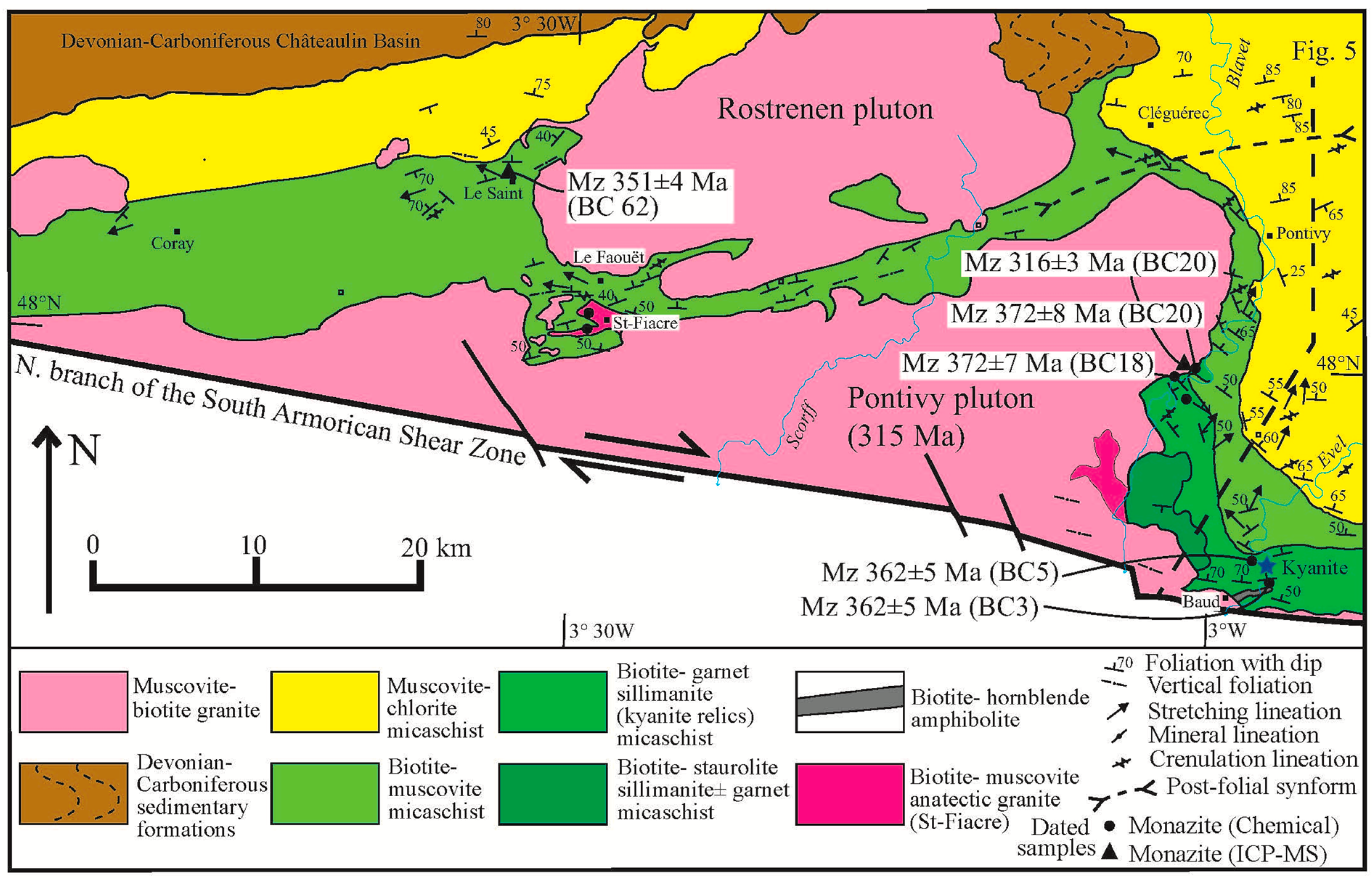
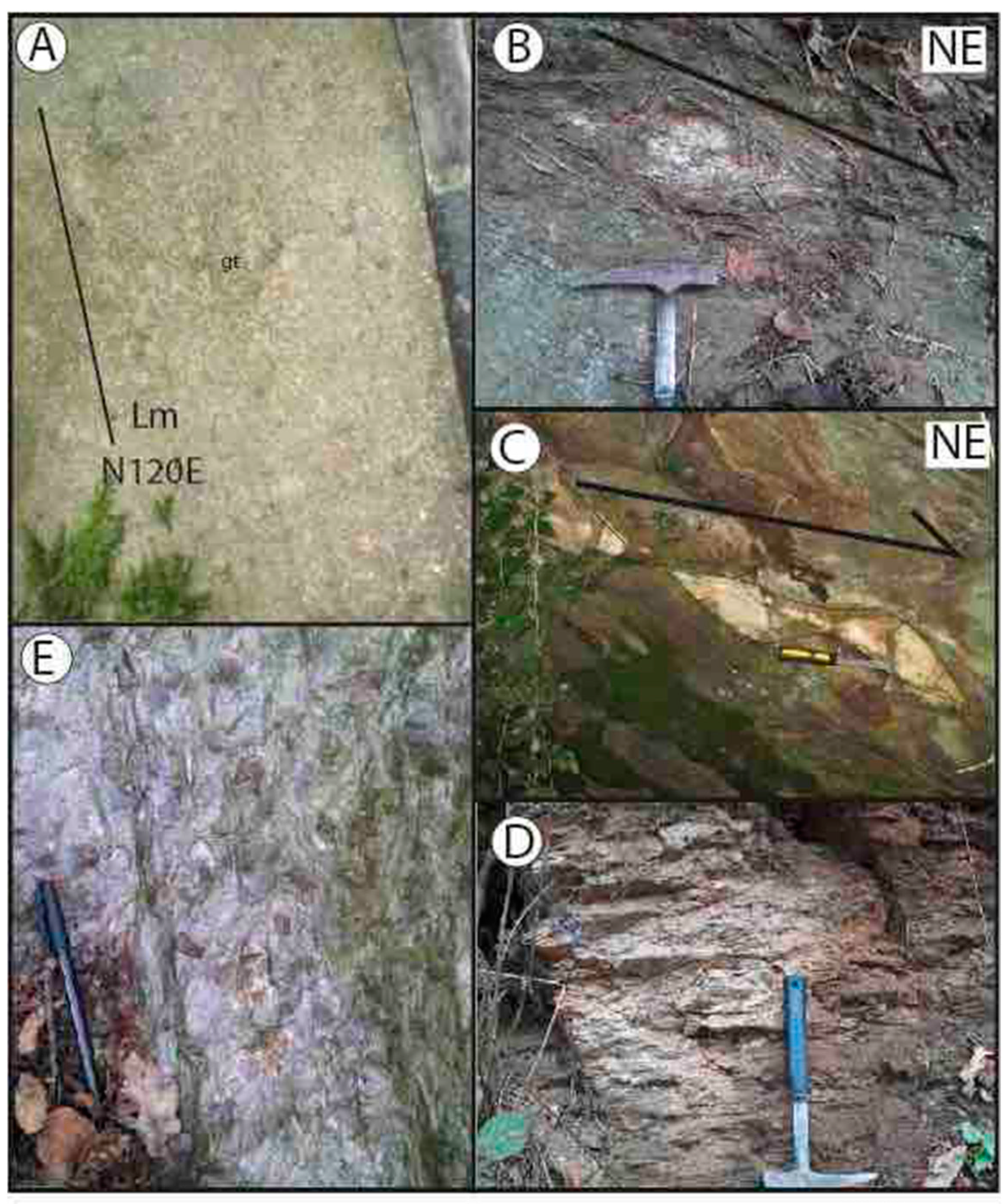
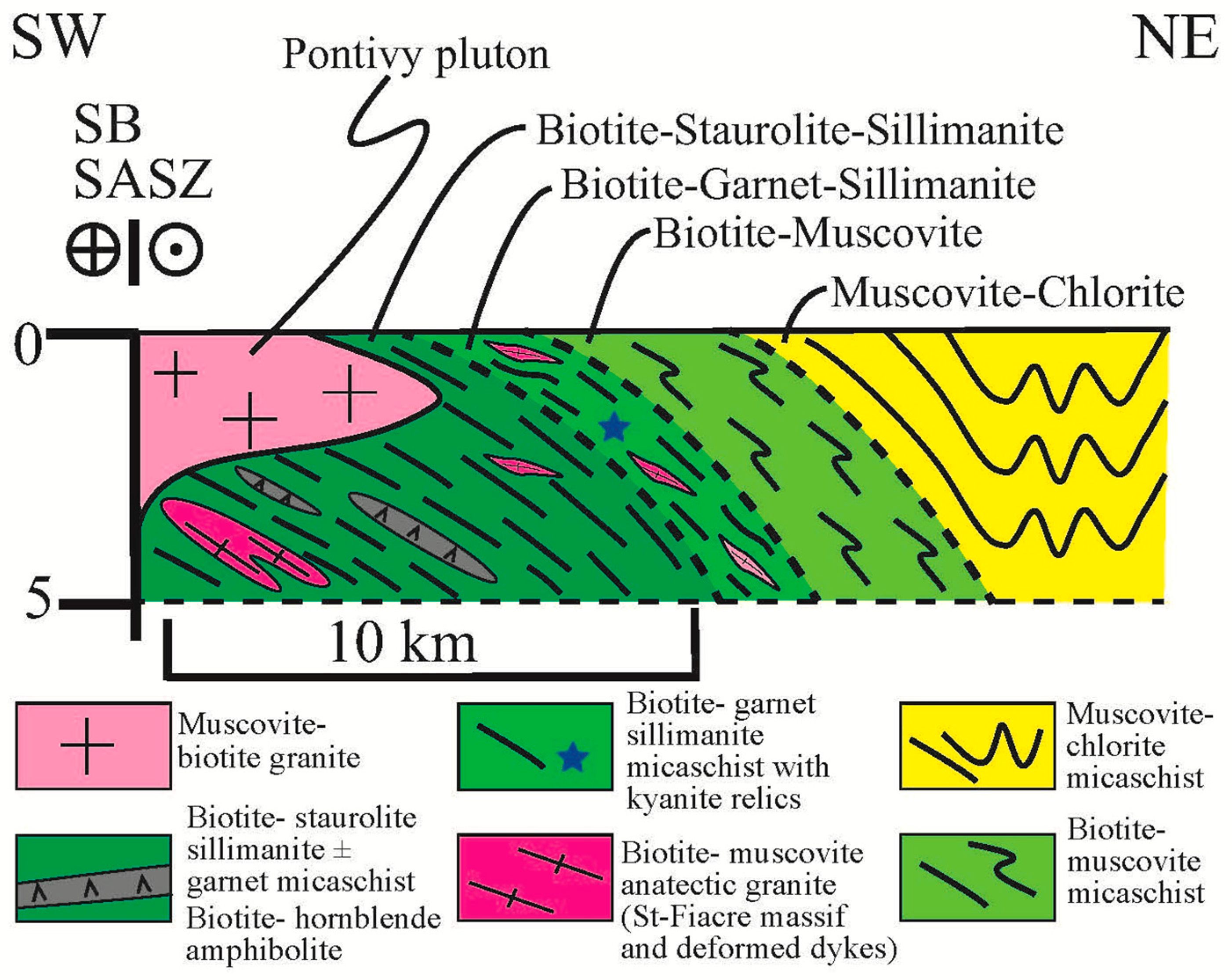


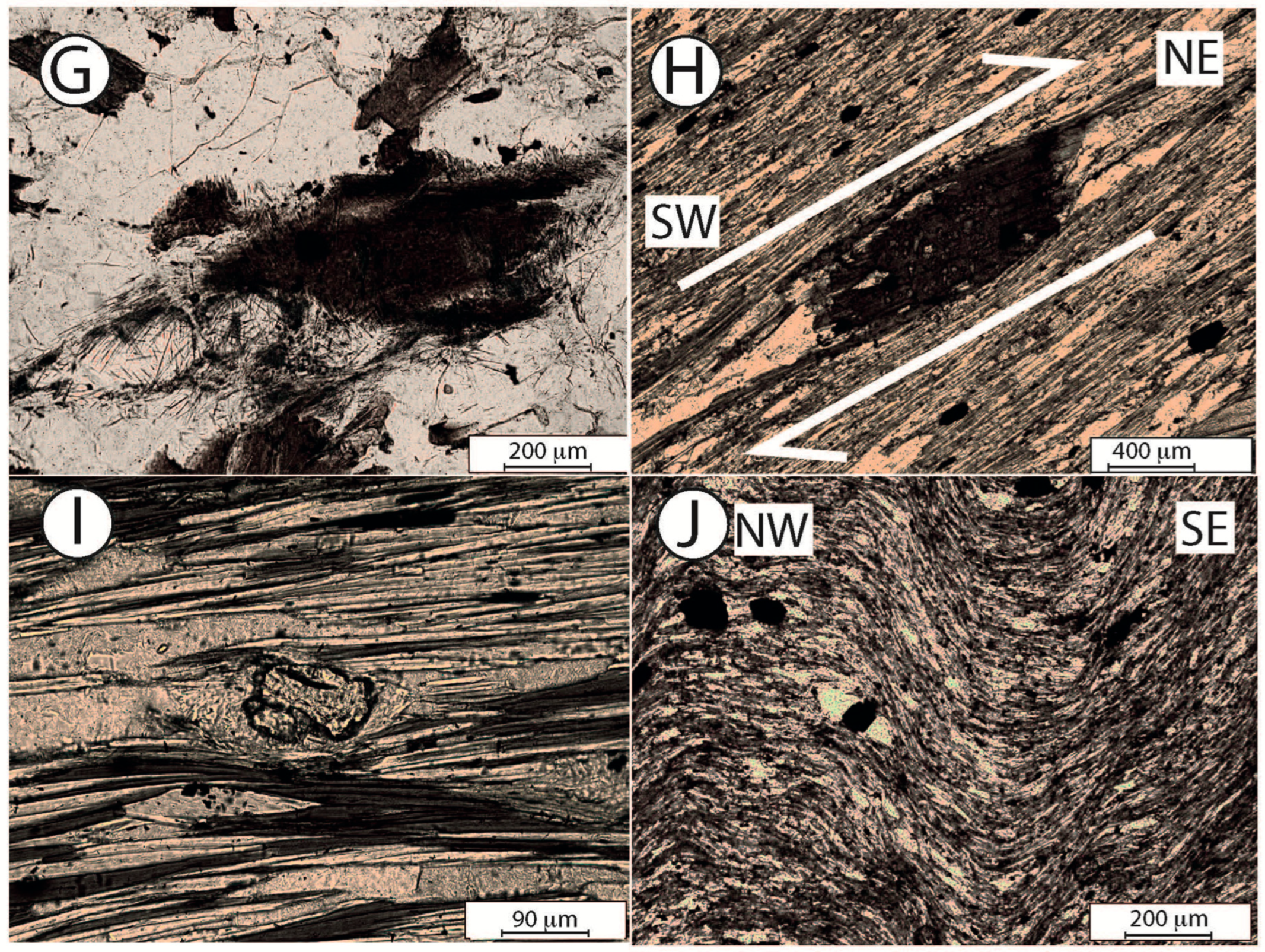
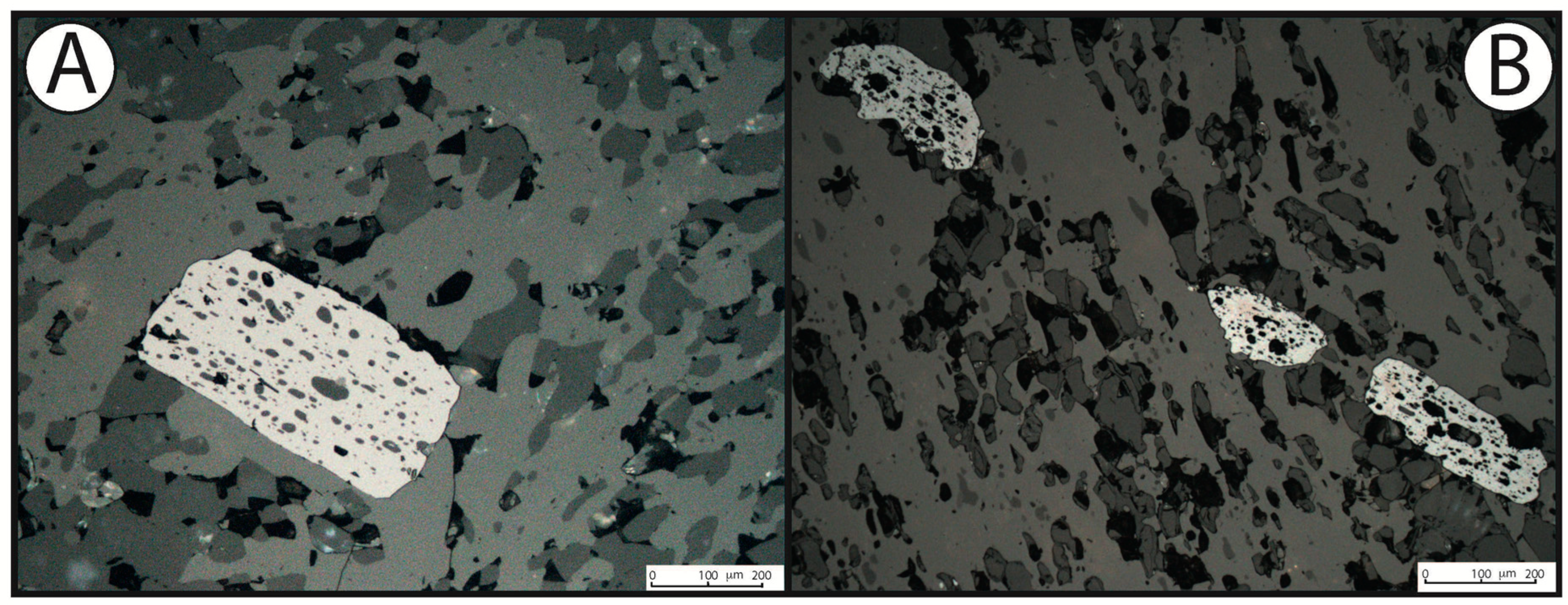
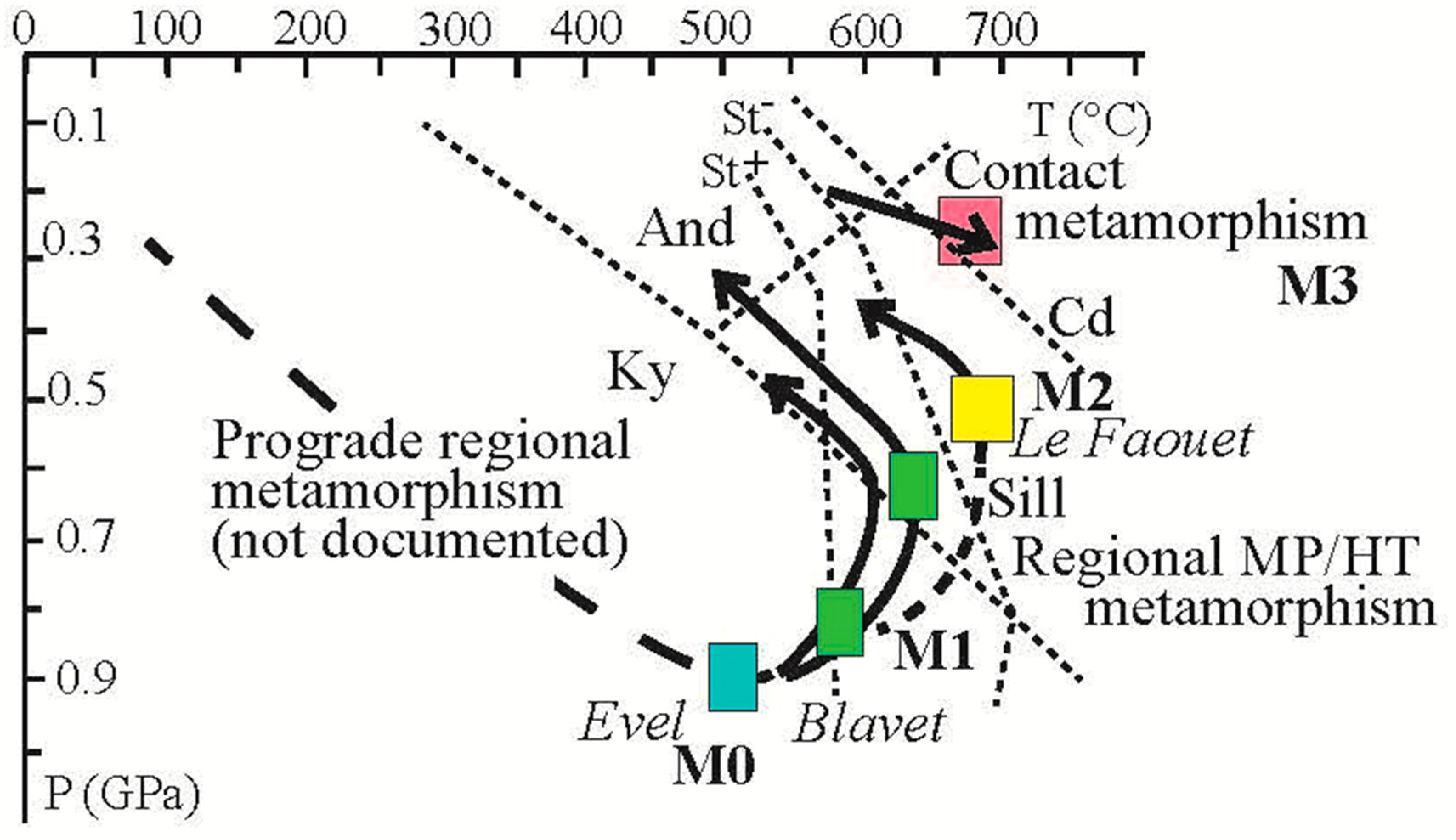

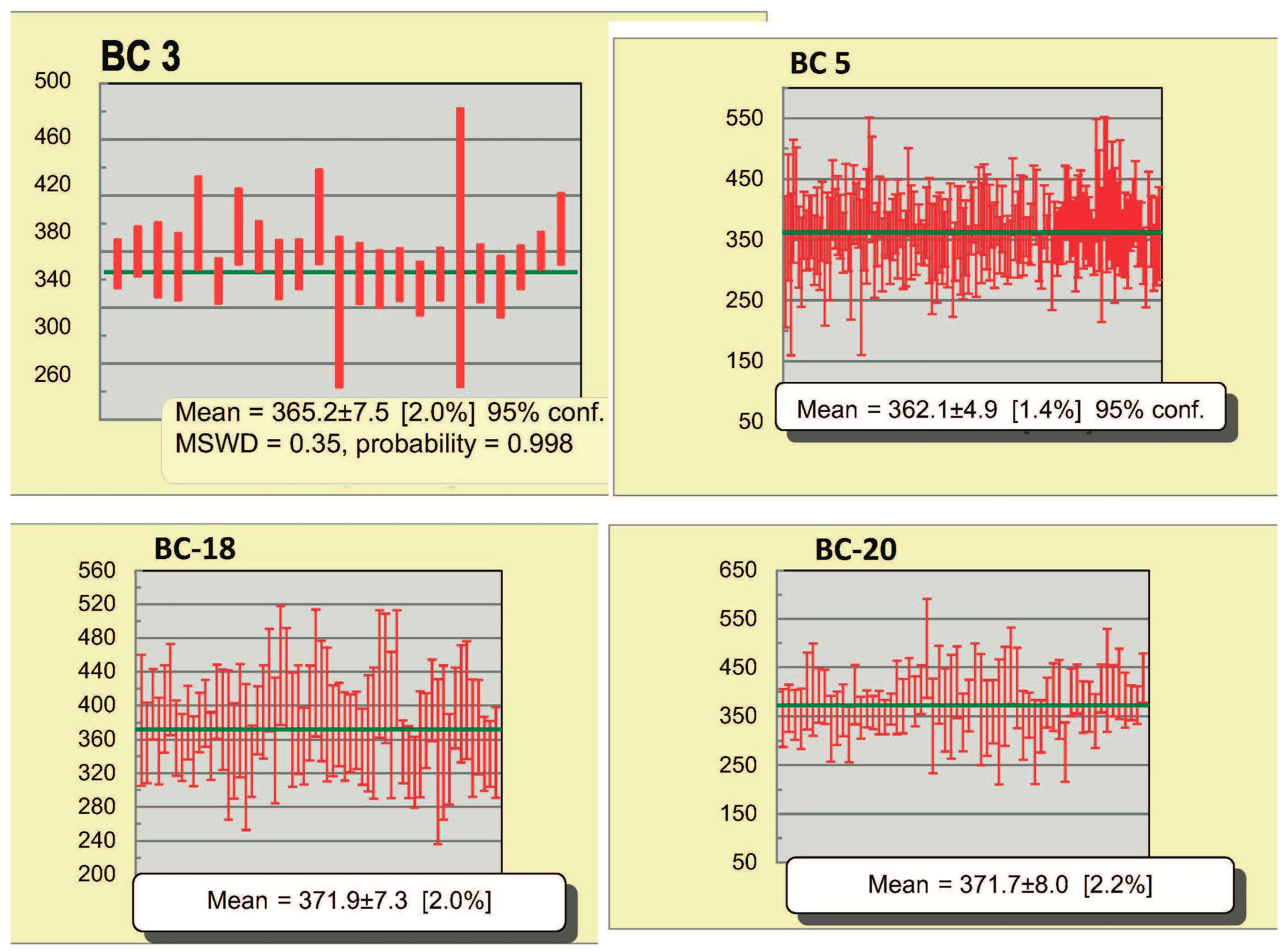
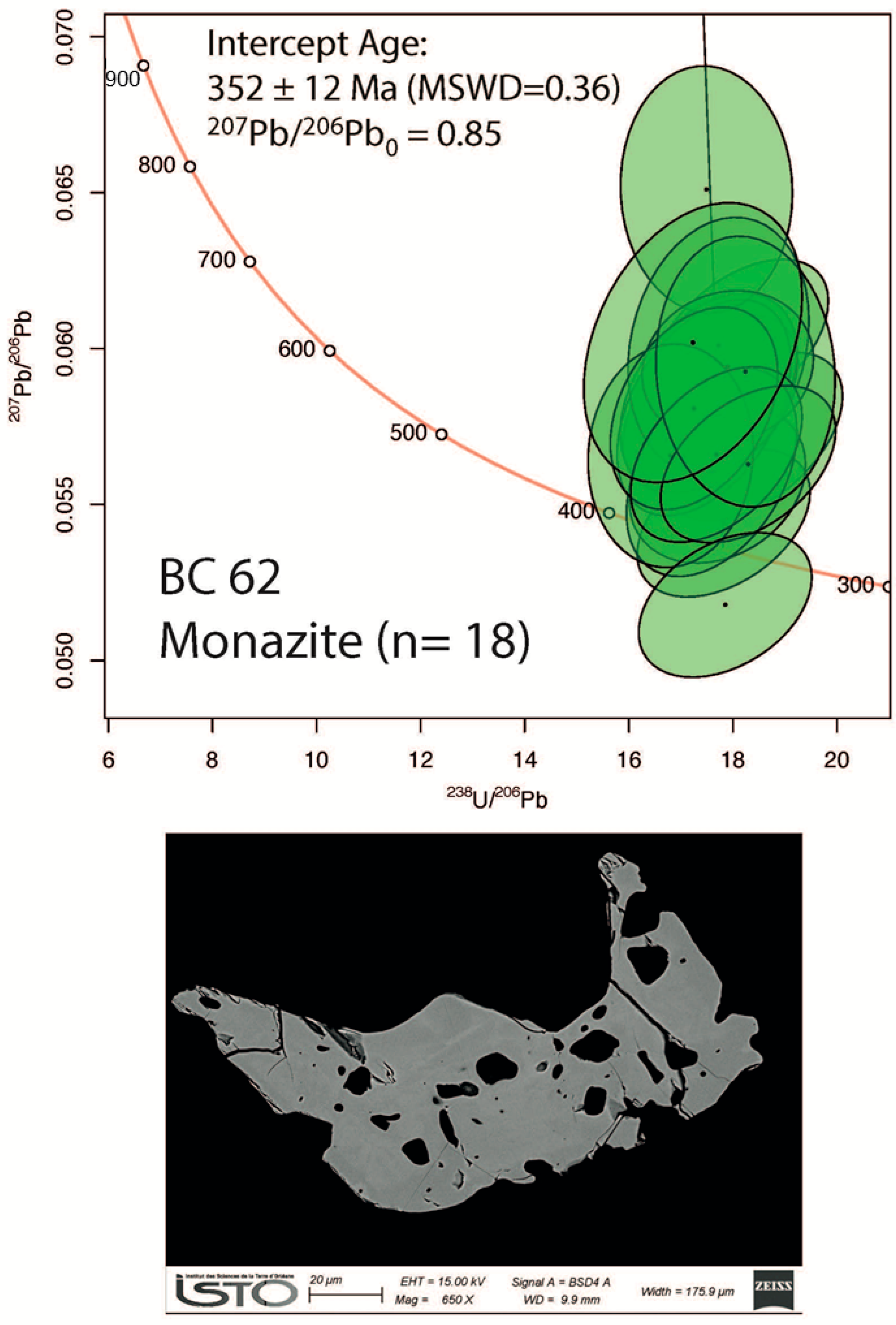
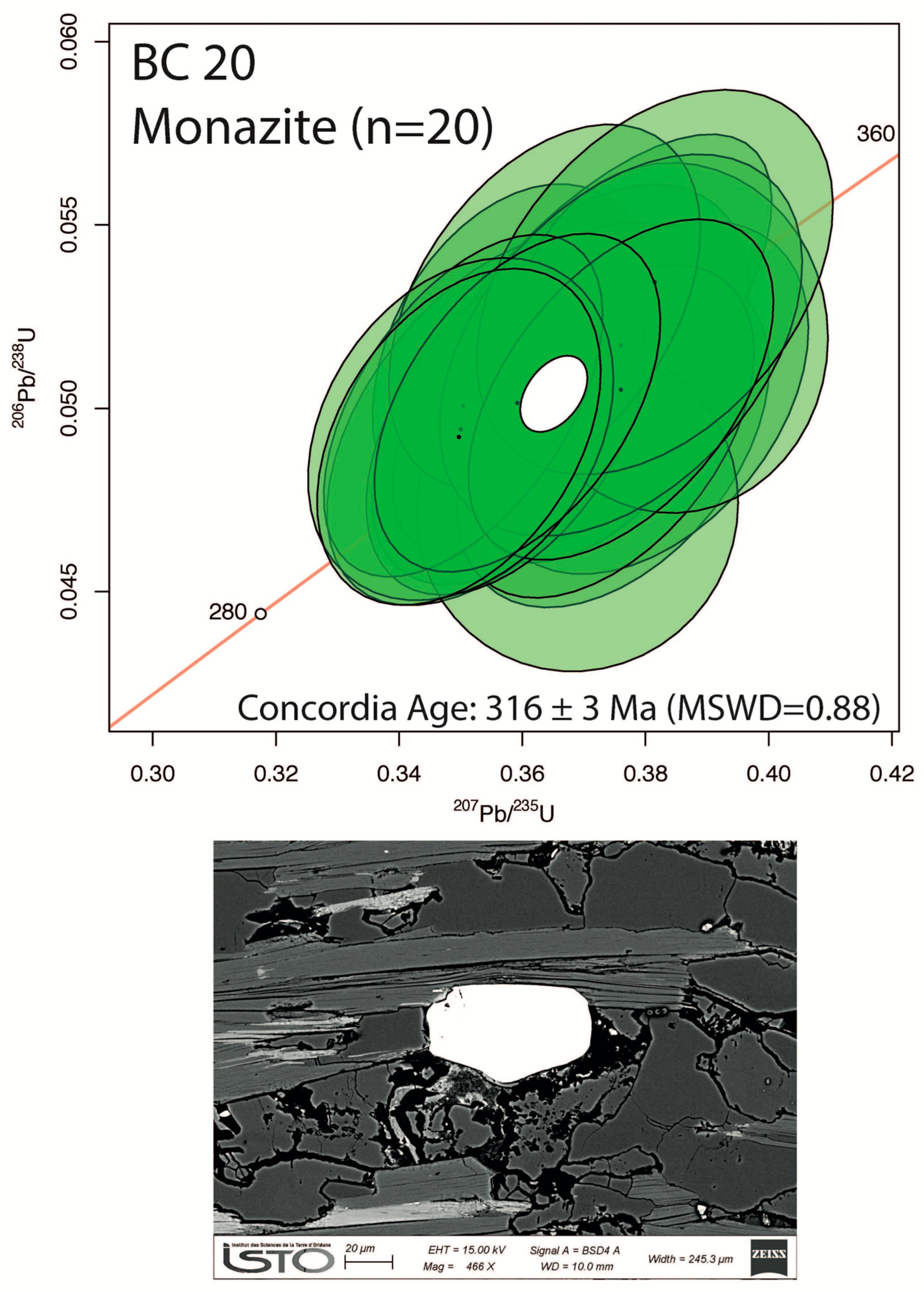
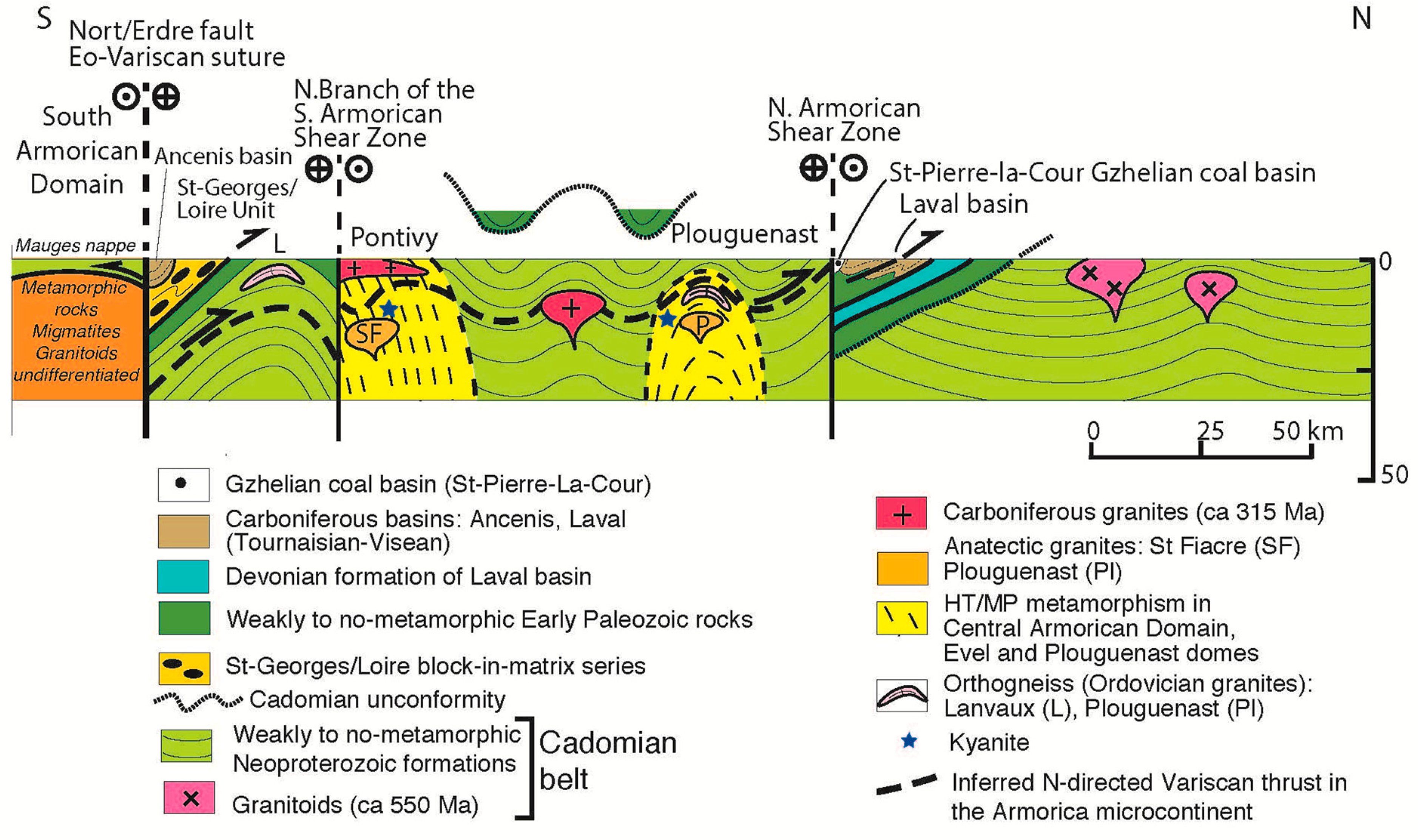

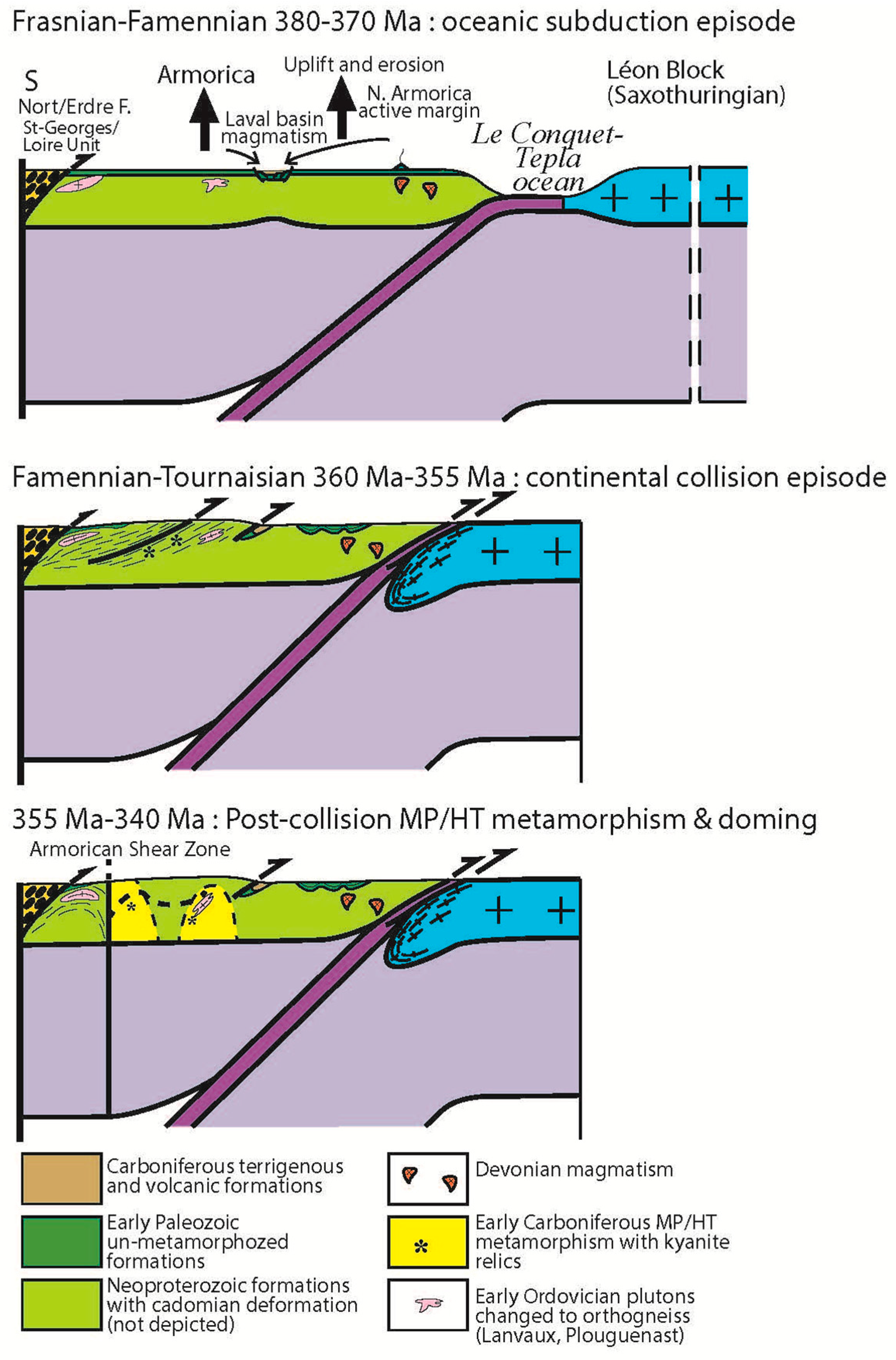
| Laboratory and Sample Preparation | |
|---|---|
| Laboratory name | GeOHeLiS Analytical Platform, OSUR, Univ of Rennes, France |
| Sample type/mineral | Monazite |
| Sample preparation | In thin-section |
| Laser ablation system | |
| Make, model and type | ESI NWR193UC, Excimer |
| Ablation cell | ESI NWR TwoVol2 |
| Laser wavelength | 193 nm |
| Pulse width | <5 ns |
| Fluence | 3 J/cm2 |
| Repetition rate | 2 Hz |
| Spot size | 8 μm |
| Sampling mode/pattern | Single spot |
| Carrier gas | 100% He, Ar make-up gas and N2 (3 mL/mn) combined using in-house smoothing device |
| Background collection | 20 s |
| Ablation duration | 45 s |
| Wash-out delay | 15 s |
| Cell carrier gas flow (He) | 0.76 L/min |
| ICP-MS Instrument | |
| Make, model and type | Agilent 7700x, Q-ICP-MS |
| Sample introduction | Via conventional tubing |
| RF power | 1350 W |
| Sampler, skimmer cones | Ni |
| Extraction lenses | X type |
| Make-up gas flow (Ar) | 0.67 L/min |
| Detection system | Single collector secondary electron multiplier |
| Data acquisition protocol | Time-resolved analysis |
| Scanning mode | Peak hopping, one point per peak |
| Detector mode | Pulse counting, dead time correction applied, and analog mode when signal intensity >~106 cps |
| Masses measured | 204(Hg + Pb), 206Pb, 207Pb, 208Pb, 232Th, 238U |
| Integration time per peak | 10–30 ms |
| Sensitivity/efficiency | 20,000 cps/ppm Pb (50 µm, 10 Hz) |
| Data Processing | |
| Gas blank | 20 s on-peak |
| Calibration strategy | Moacyr monazite used as primary reference material, Manangoutry monazite used as secondary reference material (quality control) |
| Reference material info | Moacyr [75] Manangoutry [76] |
| Data processing package used | Iolite 4 [77] |
| Mass discrimination | Standard sample bracketing with 207Pb/206Pb, 206/238U, 208Pb/232Th normalized to reference material Trebilcock |
| Common Pb correction | No common Pb correction |
| Uncertainty level and propagation | Ages are quoted at 2 sigma absolute, propagation is by quadratic addition. Reproducibility and age uncertainty of reference material are propagated. |
| Quality control/validation | Manangoutry: 544 ± 10 Ma (MSWD = 0.6; n = 5) |
| GeOHeLiS Platform, Université de Rennes | Data for Tera-Wasserburg Plot | Data for Wetherill Plot | Dates | |||||||||||||||||
|---|---|---|---|---|---|---|---|---|---|---|---|---|---|---|---|---|---|---|---|---|
| Identifier | U ppm | Th ppm | Pb ppm | 238U/206Pb | 2se% | 207Pb/206Pb | 2se% | rho | 207Pb/235U | 2se% | 206Pb/238U | 2se% | Rho | 207Pb/206Pb | 2se (abs) | 206Pb/238U | 2se (abs) | 207Pb/235U | 2se (abs) | % conc |
| BC20 | ||||||||||||||||||||
| S220519a-02.d | 8266 | 32,327 | 528 | 20.06 | 7.5 | 0.05342 | 2.6 | 0.26 | 0.3597 | 5.4 | 0.04984 | 7.5 | 0.50 | 346 | 59 | 314 | 23 | 312 | 14 | 100.5 |
| S220519a-03.d | 3864 | 17,632 | 324 | 19.46 | 7.4 | 0.05073 | 2.7 | 0.41 | 0.3584 | 5.1 | 0.05139 | 7.4 | 0.34 | 227 | 63 | 323 | 23 | 311 | 14 | 103.9 |
| S220519a-04.d | 3110 | 19,071 | 349 | 20.34 | 7.5 | 0.05487 | 3.4 | 0.32 | 0.3749 | 5.4 | 0.04915 | 7.5 | 0.43 | 406 | 76 | 309 | 23 | 323 | 15 | 95.7 |
| S220519a-05.d | 5532 | 27,567 | 430 | 19.56 | 7.8 | 0.05267 | 3.8 | 0.49 | 0.3701 | 5.8 | 0.05114 | 7.8 | 0.43 | 314 | 87 | 322 | 25 | 320 | 16 | 100.5 |
| S220519a-06.d | 3889 | 18,530 | 313 | 19.83 | 7.4 | 0.05220 | 2.7 | 0.40 | 0.3694 | 5.1 | 0.05042 | 7.4 | 0.36 | 293 | 63 | 317 | 23 | 319 | 14 | 99.3 |
| S220519a-07.d | 6314 | 46,556 | 700 | 20.12 | 8.2 | 0.05260 | 3.6 | 0.40 | 0.3552 | 6.1 | 0.04969 | 8.2 | 0.50 | 311 | 82 | 313 | 25 | 309 | 16 | 101.3 |
| S220519a-08.d | 4014 | 19,572 | 320 | 19.32 | 8.9 | 0.05381 | 4.5 | 0.51 | 0.3697 | 6.7 | 0.05175 | 8.9 | 0.68 | 362 | 102 | 325 | 28 | 319 | 18 | 101.8 |
| S220519a-09.d | 4076 | 61,299 | 997 | 19.88 | 7.7 | 0.05517 | 3.6 | 0.98 | 0.3800 | 5.6 | 0.05029 | 7.7 | 0.39 | 418 | 80 | 316 | 24 | 327 | 16 | 96.7 |
| S220519a-10.d | 3158 | 33,397 | 552 | 21.15 | 7.6 | 0.05586 | 3.9 | 0.01 | 0.3689 | 5.7 | 0.04729 | 7.6 | 0.03 | 446 | 87 | 298 | 22 | 319 | 16 | 93.4 |
| S220519a-11.d | 4773 | 31,334 | 550 | 20.26 | 7.4 | 0.05449 | 2.7 | 0.33 | 0.3735 | 5.2 | 0.04937 | 7.4 | 0.47 | 390 | 60 | 311 | 22 | 322 | 14 | 96.4 |
| S220519a-12.d | 4148 | 29,278 | 463 | 20.22 | 7.4 | 0.05211 | 2.7 | 0.46 | 0.3573 | 5.1 | 0.04946 | 7.4 | 0.46 | 289 | 63 | 311 | 22 | 310 | 14 | 100.3 |
| S220519a-13.d | 2305 | 13,115 | 220 | 19.26 | 7.4 | 0.05497 | 3.5 | 0.02 | 0.3843 | 5.3 | 0.05192 | 7.4 | 0.00 | 410 | 77 | 326 | 24 | 330 | 15 | 98.8 |
| S220519a-14.d | 2752 | 15,439 | 259 | 18.95 | 7.6 | 0.05097 | 3.7 | 0.39 | 0.3636 | 5.6 | 0.05276 | 7.6 | 0.42 | 239 | 86 | 331 | 25 | 315 | 15 | 105.2 |
| S220519a-15.d | 3137 | 34,412 | 521 | 19.33 | 8.1 | 0.05484 | 4.7 | 0.44 | 0.3760 | 6.3 | 0.05172 | 8.1 | 0.43 | 405 | 105 | 325 | 26 | 324 | 17 | 100.3 |
| S220519a-16.d | 2663 | 31,728 | 513 | 18.71 | 7.9 | 0.05262 | 4.8 | 0.50 | 0.3815 | 6.1 | 0.05344 | 7.9 | 0.40 | 311 | 109 | 336 | 26 | 328 | 17 | 102.3 |
| S220519a-17.d | 4542 | 35,473 | 566 | 19.97 | 7.5 | 0.05142 | 2.7 | 0.46 | 0.3504 | 5.2 | 0.05007 | 7.5 | 0.53 | 259 | 62 | 315 | 23 | 305 | 14 | 103.3 |
| S220519a-18.d | 3661 | 54,693 | 877 | 19.80 | 7.4 | 0.05473 | 3.0 | 0.19 | 0.3760 | 5.3 | 0.05051 | 7.4 | 0.51 | 400 | 67 | 318 | 23 | 324 | 15 | 98.0 |
| S220519a-19.d | 3185 | 26,703 | 421 | 20.23 | 7.6 | 0.05142 | 4.2 | 0.42 | 0.3500 | 5.7 | 0.04943 | 7.6 | 0.29 | 259 | 96 | 311 | 23 | 305 | 15 | 102.1 |
| S220519a-20.d | 5665 | 14,883 | 253 | 19.94 | 7.4 | 0.05205 | 2.7 | 0.37 | 0.3592 | 5.2 | 0.05015 | 7.4 | 0.48 | 287 | 63 | 315 | 23 | 312 | 14 | 101.2 |
| S220519a-21.d | 4499 | 49,067 | 777 | 20.32 | 7.5 | 0.05158 | 3.1 | 0.39 | 0.3497 | 5.3 | 0.04922 | 7.5 | 0.39 | 266 | 72 | 310 | 23 | 304 | 14 | 101.7 |
| BC62 | ||||||||||||||||||||
| S220519a-23.d | 3564 | 39,093 | 686 | 18.12 | 7.6 | 0.06024 | 3.5 | 0.49 | 0.4486 | 5.4 | 0.05519 | 7.6 | 0.32 | 611 | 75 | 346 | 26 | 376 | 17 | 92.0 |
| S220519a-24.d | 3222 | 24,048 | 419 | 18.37 | 7.6 | 0.05718 | 3.8 | 0.48 | 0.4240 | 5.6 | 0.05444 | 7.6 | 0.26 | 498 | 83 | 342 | 25 | 359 | 17 | 95.2 |
| S220519a-25.d | 2223 | 39,703 | 776 | 17.82 | 7.5 | 0.05440 | 3.5 | 0.42 | 0.4267 | 5.3 | 0.05612 | 7.5 | 0.29 | 387 | 79 | 352 | 26 | 361 | 16 | 97.5 |
| S220519a-26.d | 2628 | 15,781 | 286 | 17.70 | 7.7 | 0.05568 | 3.7 | 0.23 | 0.4358 | 5.7 | 0.05651 | 7.7 | 0.18 | 439 | 83 | 354 | 26 | 367 | 18 | 96.5 |
| S220519a-27.d | 2450 | 45,502 | 798 | 17.56 | 7.7 | 0.05825 | 3.9 | 0.47 | 0.4661 | 5.8 | 0.05693 | 7.7 | 0.36 | 538 | 86 | 357 | 27 | 389 | 19 | 91.9 |
| S220519a-28.d | 2609 | 48,838 | 821 | 17.53 | 7.8 | 0.05857 | 4.4 | 0.40 | 0.4577 | 6.0 | 0.05703 | 7.8 | 0.33 | 550 | 96 | 358 | 27 | 383 | 19 | 93.4 |
| S220519a-29.d | 1646 | 20,034 | 395 | 17.44 | 7.7 | 0.05810 | 4.8 | 0.43 | 0.4551 | 6.0 | 0.05735 | 7.7 | 0.28 | 533 | 105 | 359 | 27 | 381 | 19 | 94.4 |
| S220519a-30.d | 2612 | 42,238 | 777 | 17.49 | 7.6 | 0.06510 | 4.9 | 0.03 | 0.4978 | 6.7 | 0.05718 | 7.6 | 0.48 | 777 | 103 | 358 | 27 | 410 | 23 | 87.4 |
| S220519a-31.d | 1628 | 30,068 | 540 | 17.72 | 7.9 | 0.06010 | 5.5 | 0.19 | 0.4603 | 6.9 | 0.05643 | 7.9 | 0.31 | 606 | 120 | 354 | 27 | 384 | 22 | 92.0 |
| S220519a-32.d | 2448 | 37,859 | 676 | 17.90 | 7.4 | 0.05942 | 3.3 | 0.11 | 0.4519 | 5.3 | 0.05585 | 7.4 | 0.40 | 582 | 71 | 350 | 25 | 379 | 17 | 92.5 |
| S220519a-33.d | 1085 | 16,395 | 372 | 17.59 | 7.5 | 0.05603 | 4.8 | 0.39 | 0.4296 | 5.7 | 0.05685 | 7.5 | 0.25 | 453 | 106 | 356 | 26 | 363 | 17 | 98.2 |
| S220519a-34.d | 2050 | 36,117 | 670 | 16.80 | 7.6 | 0.05656 | 5.1 | 0.05 | 0.4537 | 6.3 | 0.05953 | 7.6 | 0.04 | 473 | 113 | 373 | 28 | 380 | 20 | 98.1 |
| S220519a-35.d | 1117 | 20,576 | 480 | 17.25 | 7.5 | 0.05808 | 4.5 | 0.35 | 0.4556 | 5.6 | 0.05799 | 7.5 | 0.32 | 532 | 99 | 363 | 26 | 381 | 18 | 95.3 |
| S220519a-36.d | 1861 | 18,574 | 365 | 17.68 | 7.5 | 0.05660 | 4.0 | 0.43 | 0.4357 | 5.6 | 0.05655 | 7.5 | 0.27 | 475 | 89 | 355 | 26 | 367 | 17 | 96.6 |
| S220519a-37.d | 1919 | 47,271 | 810 | 18.29 | 7.4 | 0.05629 | 3.6 | 0.43 | 0.4268 | 5.3 | 0.05467 | 7.4 | 0.34 | 463 | 80 | 343 | 25 | 361 | 16 | 95.1 |
| S220519a-38.d | 2651 | 19,238 | 338 | 18.24 | 7.6 | 0.05926 | 5.9 | 0.07 | 0.4584 | 8.0 | 0.05482 | 7.6 | 0.32 | 576 | 128 | 344 | 25 | 383 | 26 | 89.8 |
| S220519a-39.d | 3283 | 54,645 | 982 | 17.23 | 9.8 | 0.06019 | 6.0 | 0.33 | 0.4839 | 8.4 | 0.05804 | 9.8 | 0.70 | 609 | 129 | 364 | 35 | 401 | 28 | 90.7 |
| S220519a-40.d | 2429 | 15,879 | 294 | 17.85 | 7.5 | 0.05178 | 3.6 | 0.38 | 0.4024 | 5.4 | 0.05602 | 7.5 | 0.35 | 274 | 83 | 351 | 26 | 343 | 16 | 102.3 |
| Event | Metamorphism | P-T Conditions | Structure and Tectonics | Age |
|---|---|---|---|---|
| M0 early stage of M1 | Kyanite, and aligned inclusions in porphyroblasts | 0.9–1 GPa, 500–650 °C | Not documented Intracrustal thrusting? | 360–355? |
| D1/M1 | MP/MT Biotite–staurolite–garnet | 0.8–0.6 GPa, 500 °C | Regional foliation NW-SE stretching lineation Top-to-the NW shearing Intracrustal thrusting? | 360–355 Ma |
| D2/M2 | MP/HT Sillimanite–K-feldspar muscovite | 0.6–0.5 GPa, 700–750 °C | Top-to-the NE shearing (local) NE-SW crenulation lineation Doming | 355–347 Ma |
| M3 | LP/HT Garnet–andalusite Hornfels | 0.25 GPa, 700 °C | Not investigated here Pluton emplacement | 315 Ma |
Disclaimer/Publisher’s Note: The statements, opinions and data contained in all publications are solely those of the individual author(s) and contributor(s) and not of MDPI and/or the editor(s). MDPI and/or the editor(s) disclaim responsibility for any injury to people or property resulting from any ideas, methods, instructions or products referred to in the content. |
© 2025 by the authors. Licensee MDPI, Basel, Switzerland. This article is an open access article distributed under the terms and conditions of the Creative Commons Attribution (CC BY) license (https://creativecommons.org/licenses/by/4.0/).
Share and Cite
Faure, M.; Marcoux, E.; Poujol, M.; Masson, C. How Stiff Was Armorica During the Variscan Orogeny? A Reappraisal of the “Bretonian” Phase in Central Brittany. Geosciences 2025, 15, 60. https://doi.org/10.3390/geosciences15020060
Faure M, Marcoux E, Poujol M, Masson C. How Stiff Was Armorica During the Variscan Orogeny? A Reappraisal of the “Bretonian” Phase in Central Brittany. Geosciences. 2025; 15(2):60. https://doi.org/10.3390/geosciences15020060
Chicago/Turabian StyleFaure, Michel, Eric Marcoux, Marc Poujol, and Clément Masson. 2025. "How Stiff Was Armorica During the Variscan Orogeny? A Reappraisal of the “Bretonian” Phase in Central Brittany" Geosciences 15, no. 2: 60. https://doi.org/10.3390/geosciences15020060
APA StyleFaure, M., Marcoux, E., Poujol, M., & Masson, C. (2025). How Stiff Was Armorica During the Variscan Orogeny? A Reappraisal of the “Bretonian” Phase in Central Brittany. Geosciences, 15(2), 60. https://doi.org/10.3390/geosciences15020060







